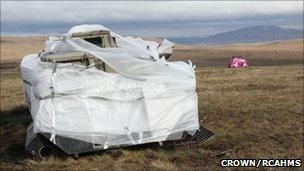Cape Wrath bombing range target undergoes makeover
- Published

The APCs on Cape Wrath that were bubble wrapped and painted pink
A defunct armoured vehicle used for target practice on a military firing range has been painted pink and another bubble wrapped for an arts project.
Called Defending the Past, the project at Cape Wrath in Sutherland involved local schoolchildren.
The bio-degradable bubble wrap was removed after five days.
Europe's largest military exercise - Joint Warrior - uses Cape Wrath twice a year for training soldiers, sailors and air crews for actual combat.
The Royal Commission of the Ancient and Historical Monuments of Scotland (RCAHMS) led Defending the Past with support from Defence Estates and the Heritage Lottery Fund.
Four armoured personnel carrier (APCs) were dressed up by schoolchildren.
They were helped by environmental artist Ruth Macdougall and Maj David Halpin, commandant of the Cape Wrath Military Training Centre.
As well as the painted and bubble wrapped vehicles, one had balloons attached to it to reflect the fact that it was flown to Cape Wrath by helicopter.
The fourth APC was clad in reflective material to make it look like an angular lochan.
Schoolchildren bubble wrap an armoured personnel carrier
RCAHMS said the ideas for the redesigns were generated by the pupils after discussion in the classroom.
A major part of Defending the Past was an invitation to schoolchildren to design a new milestone to replace one which had gone missing from a public road near the range.
Kinlochbervie High School pupil Jennifer Ross's puffin design won the competition.
The RCAHMS survey team noted the eighth milestone along the route was lost. The markers date back to the 1800s.
Playing cards featuring images of Cape Wrath have also been produced and will be handed out to military personnel training at the range.
The arts project followed RCAHMS staff spending two weeks surveying the 23 sq mile (60 sq km) range in August 2008.
They recorded traces of a Norse farm building, the remains of a hunting lodge and defences dating from World War II and the Cold War.
- Published7 July 2010